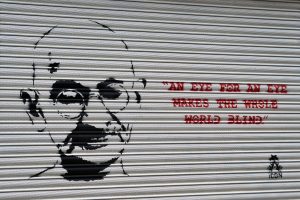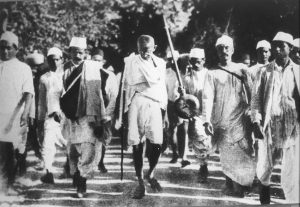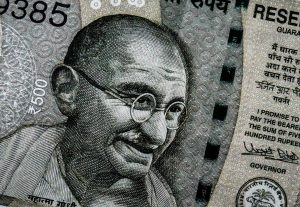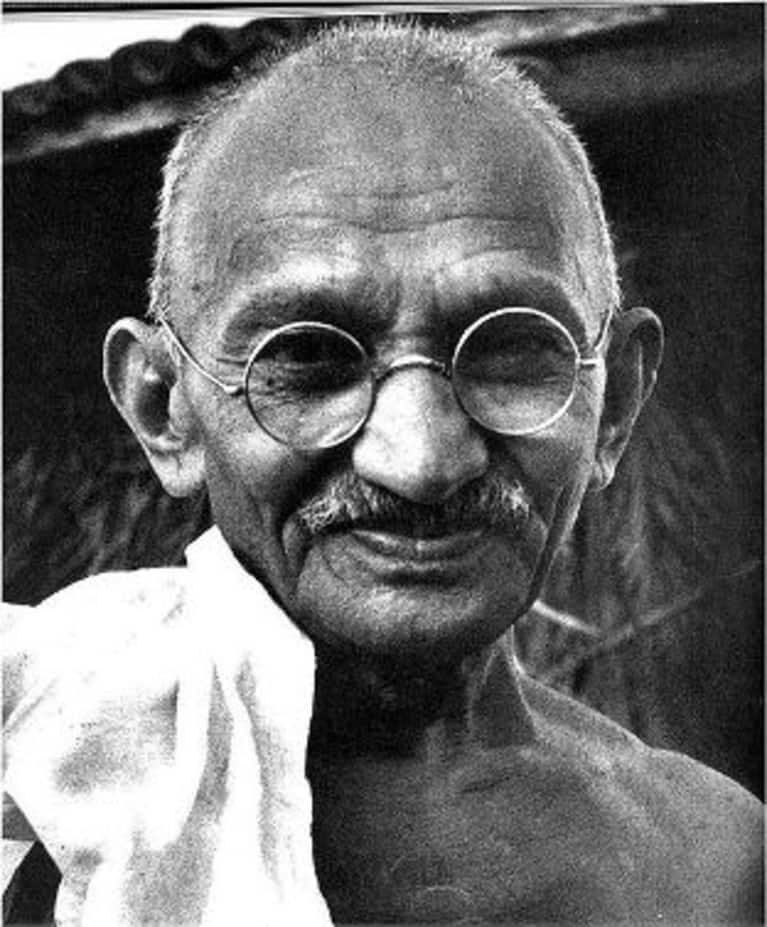On the occasion of Gandhi Jayanthi, the Ritambhara members engaged in a deep reflective dialogue on Gandhiji, his life, and his message. It seemed a fitting tribute to listen and let oneself be evoked by the many facets of Gandhiji that are brought alive in people today.
None of us can claim to know Gandhiji and every detail of his life accurately, but what we do aim through this reflective dialogue is to understand how Gandhiji’s philosophy, practices or way of life impacts our daily struggles to walk on the path of self-discovery. Is there a relevance of his struggle in our sAdhana and how does one move forward in this journey?
In Part 2, we pick up the thread of Gandhiji’s dedication to his personal sAdhana, and his uncompromising honesty to the self. To read the first part of this dialogue, click here.
G: Gandhiji was very sensitive to his own processes and to others around, which we can see in so many of his writings and observations. He understood inner work like we are doing it now; throughout his writings he was not only disclosing his inner world whether good or bad but also trying to step back and observe. This is not only private sAdhana but also the start of creative expressions and even movements!
B: He embodied the Arjuna archetypal energy so well, holding the system and self in the purview simultaneously. No wonder he struck a chord with so many people! He also found a third dimension that transcended the self and system. This was no accident, but a certain kind of inner intelligence, sincerity and love for the land.
A: In other words, passion for all. It must have been a precarious balance of holding the self and system simultaneously and deepening his sAdhana, commitment to dharma, truth etc. so that he can walk on this razor thin path.
C: By the way, he read the Gita every day. I was reading Erik Erikson’s book on Gandhiji where he mentions how Gandhiji botches up his first case in South Africa, loses his voice etc. Similar hiccups that Arjuna also went through before the beginning of the war. There was no looking back after that, when he worked on himself by digging deeper almost like innovating Patanjali’s yamA and niyamA for his own life. He wrote a small booklet called “Ashram Observances in Action” which contained details about his life at different ashrams like Sabarmati ashram etc. It included some of his observations and recommendations on things like ahimsA, asteya, untouchability etc. It served as a manual for those living in that community. I am sure he was influenced by Patanjali’s Yoga sutras.
A: I am seeing that when one is doing a practice for oneself to develop ahimsA, but when one is unable to see any indignity being caused to others it is a kind of himsA, even if it is not a direct harm. Now you can imagine that if you do a practice with that mindset and articulate it that becomes a very big deal. This is where the relevance of seeing the self and system simultaneously comes to light.
G: To understand our discussion so far, I first want to define the space of confusion where one is trying to find the truth. Without that I find it difficult to work ahead. Ashok Malhotra very nicely defined the self in two ways-:
- The self that is the agency that can act
- The relational self-i.e. you see yourself in relation to the context and as an individual
Simultaneous sensitivity to both creates a tremendous pull and push, thus creating a space of confusion where one is trying to find the truth. This is what happened in India when she was invaded so many times. The highest ideal of our cultural continuity lies with the group of people who held the simultaneity with much sensitivity. Over the years this aspiration seems to have got corrupted and gone silent. Gandhiji finally gave a voice to that aspiration, which attracted a lot of people. When he saw this great response, he made the voice louder.
 C: If I leave out the words like ‘agency’, he saw the idea of what it meant to be Gandhi as an identity that is expanding, and he also expanded with it, which took him beyond his family circles. I think this is what he was trying to articulate when talking about oceanic circles of self-governance. He often spoke about a set of ever-expanding oceanic circles starting with the self, then expanding to include ones family, village etc. Once you learn to govern yourself, it also influences the whole.
C: If I leave out the words like ‘agency’, he saw the idea of what it meant to be Gandhi as an identity that is expanding, and he also expanded with it, which took him beyond his family circles. I think this is what he was trying to articulate when talking about oceanic circles of self-governance. He often spoke about a set of ever-expanding oceanic circles starting with the self, then expanding to include ones family, village etc. Once you learn to govern yourself, it also influences the whole.
B: Like concentric circles of svaraj?
C: Yes. The only way these circles expand is if I am conscious that I am the voice of the context and individual as well. There is no expanding circle when I am unaware about the context and just concentrate on myself or my family. I think this is why yamA and niyamA are so important in yoga, they define the ways I interact with and therefore influence my context.
A: This is where the less talked about yamA, namely, aparigraha (not seeking more than ones needs i.e., voluntary simplicity) comes into the picture. In today’s world, unless one is anchored in aparigraha one is part of the global problem of over consumption and environmental degradation. Also, one does not have any energy left to listen to the voice of the larger context. One is caught with an idea of progress that keeps us trapped to a treadmill, with no time to go within.
G: One of his famous statement that ‘There is enough in this world for everybody’s need. But not enough in this world for everybody’s greed”. This sums up the modern statement for aparigraha.
D: In our search for the truth if we sincerely apply ourselves to it, we should arrive at this state of expansion quite organically. Is it not?
C: It is not so simple, because the fundamental idea that we are talking about is the quote ‘Be the change you wish to see’ and not just stop at the change. When I look at Satyagraha, I am saying, “ I will first look at my truth. Then, let me confront you with that along with my struggles, concerns and inner processes and then let us dialogue it”.
E: I am reminded of the discussions between Ambedkar and Gandhiji, where we all know the criticisms Ambedkar had of Gandhiji. Yet, Gandhiji took away some very important points like knowing the difference between indignity and humiliation. Isn’t this so inspiring?
B: Let me bring this to today’s context where everyone is engaging in ‘isms’ or a certain ideology and claiming they are correct without engaging in a dialogue that encompasses an inner growth or expansion. Gandhiji and Ambedkar had strong convictions, but they dialogued as well. This is what is inspiring.
C: True. It is not an aspired value that I hang on the wall and pray to, because it is a natural process of unfolding within me. I am merely staying true to the process despite what the context or environment reflects.
F: So, what I understand through the above is that Gandhiji kept coming back to himself with respect to the triggers, inner confrontations and so on to search for his truth.
G: It was after all an experiment that found resonance with the larger society. To me he was just experimenting with himself which is what I would call as organic.
C: Organic can also refer to not taking leaps of action, like even in biological processes there is a mutation that comes out of the organisms own struggles to survive and grow. Gandhiji’s life seems to reflect this inner struggle to make meaning of his own life, to find a purpose not just make a living. I feel that there will be an impact when you start recognizing that you are also the voice of the context, you don’t have to set yourself up as an agent of change.
D: Is there an intention in whatever I am doing along with a contextual awareness or does organic mean that I will do as I am continuing to do, and the rest will fall into place?
C: When we use terms like salvation in the Hindu context it is not something that ends with me alone. Whether we take Gandhiji or anybody else, we are a microcosm of the world. When we struggle honestly and intensely to discover truth and act from it, we are standing at the edge of a collective mind. Our action will impact the context and the collective unconscious. This is what according to me is true salvation in the Hindu sense because one must realize that ‘I’ as a separate entity does not exist. If I am experiencing deep angst, it also belongs to a larger group of people, I cannot merely interpret it in personal terms.
B: Gandhiji also realized that there is no Swaraj without Sarvodaya and svAbhimAn.
 C: One cannot go on imitating the West and borrow ideas from x,y and z but rather I need to discover my path towards the truth, my svAbhimAn, my svbhAva through my own experiments with truth. This de-colonization is what Gandhiji stood for. Sadly, we have set him and his ideas of development aside after we gained independence.
C: One cannot go on imitating the West and borrow ideas from x,y and z but rather I need to discover my path towards the truth, my svAbhimAn, my svbhAva through my own experiments with truth. This de-colonization is what Gandhiji stood for. Sadly, we have set him and his ideas of development aside after we gained independence.
D: I hear Gandhiji being talked about as a great social activist.
C: I think he was, he wanted to also reform the way Hinduism is looked at. He took off from where Tilak left his work on re-energizing Hinduism. Tilak re-wrote the Gita, which essentially was a wake-up call for all Indians, which was carried forward by Gandhiji. Tilak did immense study of the Indian context, people, scriptures etc. Terms like dharaNA, ahimsA are not new terms invented by Gandhiji but they were practiced in a way that was fresh and contextually very relevant.
B: Yes, statements like “non-cooperation” and “Swaraj is my birth right” were Tilak’s brain-child. Dharampal ji in his book on the roots of civil disobedience lists examples of ahimsA and dharaNa followed long back, much before Gandhiji gave them a new life.
D: I am also sensing that he was very kind and did not put the other person down; in this case the British. The dialogue was of a very different kind saying, “I know you are in my space and this is my right to get my space back with dignity”. A dignified fight was put forward in a simple way acting on the truth of “Swaraj is my birth right”.
C: True, the statements put out by Gandhiji were strong assertive boundaries saying, “you dare not violate my space and I will also not step into your space”
G: The Gita also defines ahimsA in a similar manner.
B: In fact, there was a lot of profound humor in the letters he wrote to the British, which became a form of anger at one level.
F: I am a bit confused about the part where we discussed the individual being at the center of a concentric circle and how the individual struggle reflects the struggle of the collective as well. When we go inwards, don’t we get so drawn in that the voice of the context vanishes within my individual self?
C: This is the confusion that prevails between the eastern, basically the Sankhya idea of the self and the western idea of an individual being an atomized separate being. An idea of being a separate entity is true at a vishesha level (the level of perceiving the world as comprising of distinct and differentiated things). The moment you look inwards you touch the avishesha level (the level of perciving the world as contiguous and interconnected), where there is no Gandhiji, you or me, as distinct individuals. This is when Gandhiji discovers the angst of millions of people like him in South Africa. He joins everyone’s struggle and allows people to join his struggle as well.
F: But at the end of all the Satyagraha that he practiced what was left was a partitioned India, and then he retreated to Noakhali, trying to figure out what is happening? How should one look at that process?
C: Look, there was a group of people who assumed power but were never with him in his inner journey. So, what can he do when Nehru and Jinnah continue to argue after so many years? His people betrayed him with respect to his ideas of Swaraj and Satyagraha. So, he goes away to question himself, what can he do now and find another level of strength to impact the system. So he comes back to see how he can stop the carnage. Internally he is intensifying his exploration of brahmachrya.
B: The last few months of Gandhiji do need a deeper look and conversation, because there were many mistakes that were made too.
 A: I also want to bring out the number of communities Gandhiji inspired to grow, whether Sabarmati or others. It was not his own spiritual search, but they were the entire group’s quest. I also hear that different Ashrams like Ramana ashram, Tagore’s ashram etc. were in constant touch with each other trying to engage in dialogues to grow. It would really be worthwhile to examine how these ashrams thrived and specifically what practices did they follow especially in those tough periods
A: I also want to bring out the number of communities Gandhiji inspired to grow, whether Sabarmati or others. It was not his own spiritual search, but they were the entire group’s quest. I also hear that different Ashrams like Ramana ashram, Tagore’s ashram etc. were in constant touch with each other trying to engage in dialogues to grow. It would really be worthwhile to examine how these ashrams thrived and specifically what practices did they follow especially in those tough periods
B: Don’t forget the Akhadas who did phenomenal work in spreading Gandhiji’s message far and wide through their own methods. In today’s context, if we need to revive some of the spirit of the soil again I think we need to tap into these grass root level institutions and support each other. I am quite fascinated by how these communities worked and the kind of exchanges that took place, for example I have heard that many freedom fighters came to Ramana ashram to recuperate and then went back, some of them who had existential questions went to Aurobindo’s ashram, or Tagore’s place for arts etc.
D: What were the kinds of exchanges that took place?
B: They used to beautify the walls of the ashram with art or mural work, write songs or poetry, write and perform plays in Tagore’s Shantiniketan. Right now, I am holding the question of what kind of community Ritambhara would like to create and how do we walk together with others in similar spaces?
A: I resonate with the great values that were talked about and hoping I can live by some of those values in my own life. Even though, I am not a social activist but still how can I relate to Gandhiji and his values? This is a question I am left with and will continue to hold.
D: I am very excited to learn about how he integrated self-disclosure in his practice. What left me in awe was how one impacts the larger community when one starts looking deeper inwards.
G: I really admire his ability to continuously dialogue with so many people he met during his lifetime, where he was willing to see multiple narratives, views and yet stick to his journey towards the truth
E: To move away from the ‘me’ or ‘my’ context to a larger context, without having to make that extra effort or goal is just amazing. As he moved inwards, he also expanded his circles like we talked about. The silence in between our statements made me think how do we use our silence; whether to express anger or displeasure or by simply observing it? Perhaps these questions that I once took seriously have faded away with time and I think I really need to read more and talk more about this.
A: I am very delighted to simply listen to this dialogue on Gandhiji and allowing it to do whatever magic it has to do. I believe Gandhiji was a sacred activist more than a social activist, because his work transcends even the social layer and moves to something more fundamental like a bhumi.
F: I am feeling full of prANa, I went back to my own reasons of committing to the path of yoga and Gandhiji was a big influence in that decision. While there has been a sort of dullness in my life currently, yet how do I keep moving forward is something I am trying to learn from Gandhiji’s life. So, I will always be grateful to him.
D: Full of prANa is such an apt phrase for what is going on within. As I go deeper I feel a bit stuck, helpless and tired as to how should I move ahead. I wish I could practice what he did during times when he was stuck.
I am also wondering how do we move forward as a community without aggression or polarizations? How do we channelize our anger or passions with respect to what is going on within and outside? Can we use arts as a medium? These are just some of the many questions that I have on the way forward

C: I am left feeling both happy and sad. Happy because we attempted to understand Gandhiji from an innocent lens and entered a very nice dialogue. Sad because the larger context of what Gandhiji stood for is getting lost while he is a marketing icon, a political mascot or a punching bag for many contrary points of views. We hardly hear people talking about his struggles and his vision for India as a nation. Where is the dialogue with Gandhiji today? I think we need it much more today than ever.
E: I am wondering if it was very tough for people to stay in the space of Gandhiji while he pursued his journey?
C: I believe few years before independence itself people got onto the bandwagon of ‘usefulness of Gandhiji’ rather than the meaning of Satyagraha.
G: I am trying to relate to Gandhiji as a role model of certain values and ideas, which are worth emulating. For example, this conversation where we brought out our reflections about the truth, fears and concerns is Gandhian to an extent. When you mention how Gandhiji is becoming irrelevant, does it refer to the way of being or are we referring to the person itself?
C: I am referring to the current Indian context. For example, the recent court judgements which is a hot topic now is a case between the colonized ideas of individual rights and the traditional Hindu idea of how to live our lives. Where was the space to dialogue and build consensus? It was merely an argument-based judgement. And the judgment did not seem to reflect a profound understanding of the tradition. It reflected a colonized mind’s idea of “rights enshrined in law”, a law that is contiguous with the pre-Independence times. In a true Indian way of resolving issues, it would have involved getting all the aggrieved parties and stakeholders together to dialogue about the practices. A dialogue based on ahimsA, satya, dharma and progress, rather than individual rights. I did not see a stream of dialogue or voice that brought forward the Gandhian values. I am also not saying that all his ideas were correct or practical, the content is not the point of discussion here. Rather, it is the process of looking at problems is what we are concerned with.
F: Then what should I be concerned with now? Should we be concerned with the facts and details about Gandhiji or the Gandhian way of life?
C: Let us keep Gandhiji and his facts aside. I am talking about the process of “experimenting with truth”, with self-disclosure, with ahimsA, and with holding the self and the system simultaneously. If the process is clear and one is true to that, then there might be an echo of the larger angst of our context in our personal sAdhana. If that happens, it is great. One cannot be forcefully going around flying the flag of ‘Being a Gandhian’. Imitation of the externals is a mugs game.
B: Different voices get fired up when we think or talk about Gandhiji, and that is what we need to stay with and work with. This is a much easier way for all of us wanting to move ahead.



 Priya is a Yoga therapist in the Krishnamacharya tradition. She adapts Reiki & energy work, Vedic chanting, life coaching & Ayurvedic practices in her healing spaces. She is committed to nurturing collectives that have the praxis of Yoga at their heart.
Priya is a Yoga therapist in the Krishnamacharya tradition. She adapts Reiki & energy work, Vedic chanting, life coaching & Ayurvedic practices in her healing spaces. She is committed to nurturing collectives that have the praxis of Yoga at their heart. Anisha has been on an exploration to understand herself through yoga for the last 15years which led her to teaching yoga, yoga therapy and inner work through yoga.
Anisha has been on an exploration to understand herself through yoga for the last 15years which led her to teaching yoga, yoga therapy and inner work through yoga. Apoorva chanced upon Yoga in her early 20s. A spark was lit within and there was no turning back. Her exploration led her to the Krishnamacharya tradition more than a decade ago. Curious about human behaviour and what drives it, she was thrilled when her search ended (and also began) when she first came upon the Yoga Sutra, which illuminated a path towards answering many questions that had been held for a long time.
Apoorva chanced upon Yoga in her early 20s. A spark was lit within and there was no turning back. Her exploration led her to the Krishnamacharya tradition more than a decade ago. Curious about human behaviour and what drives it, she was thrilled when her search ended (and also began) when she first came upon the Yoga Sutra, which illuminated a path towards answering many questions that had been held for a long time. Anita is a yoga teacher and therapist in the tradition of Sri.T.Krishnamacarya and Sri T.K.V. Desikachar, a Reiki practitioner and a Life Coach. She is also the founder of Vishoka, a center for learning Indic and energy-based frameworks for living and healing. Her deep concern for human suffering and the problems of unsustainable living kept her on the path of seeking an integrated approach to looking at life, living, learning and healing.
Anita is a yoga teacher and therapist in the tradition of Sri.T.Krishnamacarya and Sri T.K.V. Desikachar, a Reiki practitioner and a Life Coach. She is also the founder of Vishoka, a center for learning Indic and energy-based frameworks for living and healing. Her deep concern for human suffering and the problems of unsustainable living kept her on the path of seeking an integrated approach to looking at life, living, learning and healing. Ankit is a seeker in the wisdom traditions of India. The core of his work includes creating dialogic spaces where people can look within and see the connection between their inner and outer lives. Inspired by the likes of Gandhi, Aurobindo, Vivekananda and Guru Gobind his experiments in service took him back to his roots in Punjab where he is creating a community-led model of higher education which is open, inclusive and accessible for all. Ritambhara for him is a space for engaging in a community which is committed to a DHramic life. He anchors his work of learning and leadership in the Antaranga Yoga Sadhana and the humanistic wisdom of Mahabharata.
Ankit is a seeker in the wisdom traditions of India. The core of his work includes creating dialogic spaces where people can look within and see the connection between their inner and outer lives. Inspired by the likes of Gandhi, Aurobindo, Vivekananda and Guru Gobind his experiments in service took him back to his roots in Punjab where he is creating a community-led model of higher education which is open, inclusive and accessible for all. Ritambhara for him is a space for engaging in a community which is committed to a DHramic life. He anchors his work of learning and leadership in the Antaranga Yoga Sadhana and the humanistic wisdom of Mahabharata.